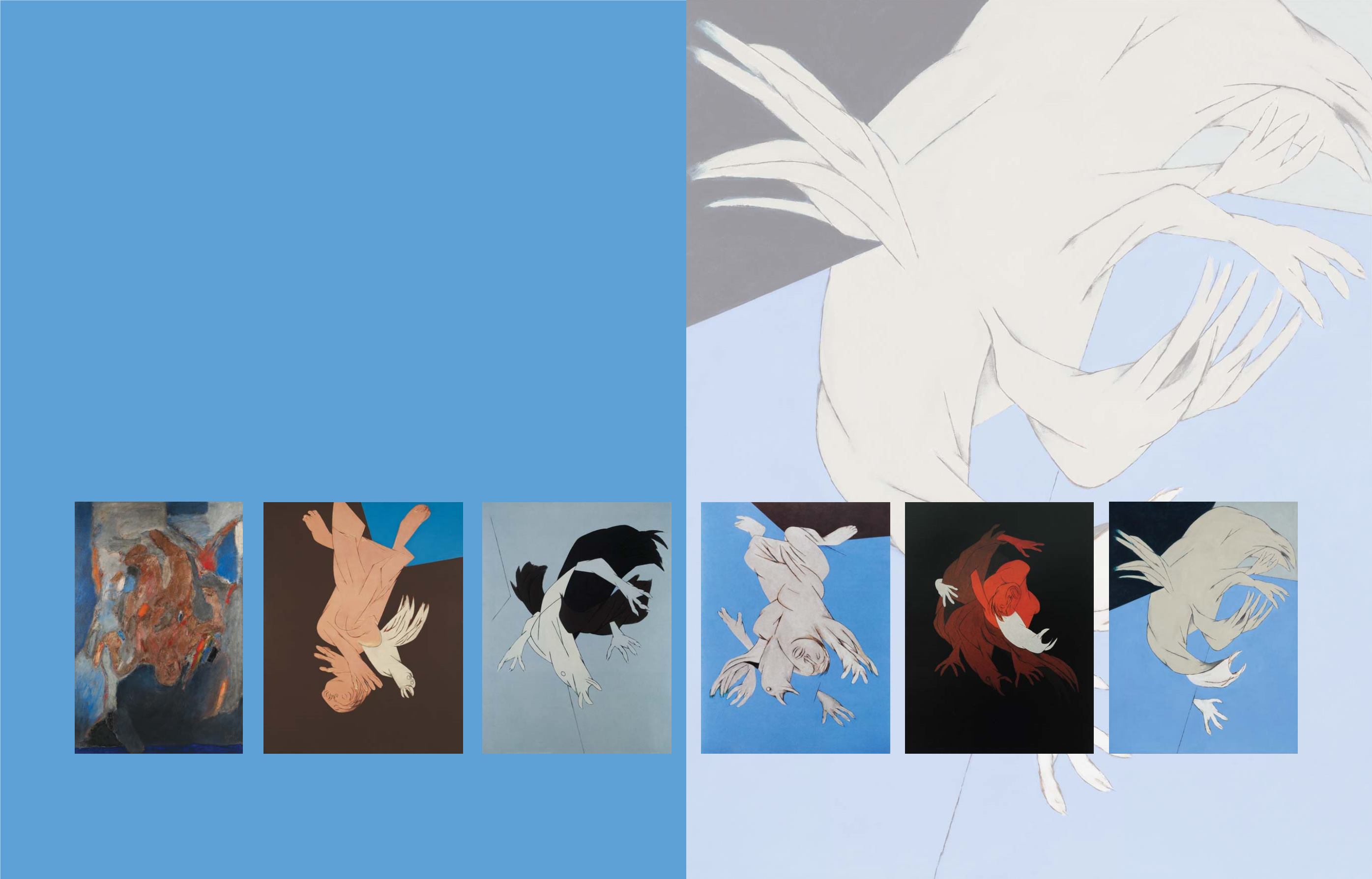

Falling Figure with Bird
, 2002
Reproduced from
Tyeb Mehta: Ideas Images Exchanges
, p. 229
Falling Figure with Bird
, 2003
Reproduced from
Tyeb Mehta: Ideas Images Exchanges
, p. 231
Falling Bird
, 2004
Present lot
his paintings was trussed, the bird who ought to have
spread his wings to fly was instead, tumbling down like
a rock. Describing the present lot, Dalmia writes: “...the
bone‒white bird sinks downwards its feathers echoing
dismembered hands separated by a calm blue sky,
clutching itself, as it seems to fall upon us. The gruesome
falling act, made even more surreal by the placid nature
of its backdrop, heightens the act of cruelty inherent in
the painting, and thus in nature.” (Dalmia, p. 25)
“Is this an image of a man and bird wrestling in contorted
embrace, all the way down their spiralling fall? What
bird is this, lost in fall, toppling, shockingly falling at and
even on top of us through a shift of gaze: its feathers
form a dismembered hand, clutching at feathers, cut
by a blue plane of sky.” (Ranjit Hoskote, Ramchandra
Gandhi et al.,
Tyeb Mehta: Ideas Images Exchanges
, New
Delhi: Vadehra Art Gallery, 2005, p. 42) Mehta dissects
the austere background into four cleanly defined colour
planes, which intersect to further splinter the falling
creature. Unlike the chaotic abyss of his earliest
Falling
Figure
, the present lot reflects influences of the Colour
Field paintings of American abstractionists which Mehta
encountered during his Rockefeller III Fund Fellowship in
New York in 1968. In particular, it was Barnett Newman,
whose “monochromatic fields of color and strong vertical
dividing lines proved critical for Mehta’s own pictorial
vocabulary.” (Edward Saywell,
Bharat Ratna! Jewels of
Modern Indian Art
, Boston: Boston Museum of Fine Arts,
2009‒10, p. 11)
This painting is striking for its minimalism and restraint.
By creating its own enigmatic narrative, it takes its place
alongside some of the most iconic Mehta works that are
much sought after by connoisseurs and collectors.
TyebMehta’s art was focussed on subjects that referred to
the complexities and dilemmas of the human condition.
From his iconic “falling figure” to the trussed bull, Mehta
explored a concise repertoire of subjects through an
artistic career marked by quiet intensity. Whether the
figures were human, animal or bird, they conveyed—at
times even screamed—a sense of disquieting torment
and trauma. These figures in crisis are at once, fantastical
and earth‒bound: unforgiving goddesses fighting
demons to the death, rickshaw‒pullers, trussed bulls, and
birds and humans hurtling through the void.
The present lot, a human and bird companion in free
fall, has its roots in Mehta’s
Falling Figure
series, which he
first began painting in the mid‒sixties. By the late‒1980s,
Mehta had begun morphing the falling figure with that
of a bird, a flurry of limbs and feathers, merging into a
strange, composite creature. Over the following decade,
the falling bird began to take centre stage. Mehta
elaborates, “I did the first drawing of the bird as far back
as 1983 but as I went along I generally began to feel
that the bird always flies so why not make it fall—it’s a
contradiction in terms. The bird can be made without
bringing in flying because that has a different kind of
body‒lifting movement. Falling means you have more
or less given up. It’s an interesting idea because I work
on fragmentation. It’s one of my preoccupations.” (Artist
quoted in Yashodhara Dalmia,
Tyeb Mehta: Triumph of
Vision
, New Delhi: Vadehra Art Gallery, 2011, p. 25)
Perhaps referencing the mythologies of Icarus and
Jatayu, or invoking the literature of Camus, because
Mehta was a well‒read artist, the painting presents a
worldview wrought with myths and juxtaposition, with
hints of the absurd. Mehta’s son, Yusuf points out that
the artist worked with oxymorons. The powerful bull in
Falling Figure
, 1965
Gold medal award winner at the First Triennale
of Contemporary World Art in New Delhi in 1968
Saffronart, 16 February 2017, lot 46
Sold for Rs 6 crores ($909,091)
Bird
, 1999
Reproduced from Ranjit Hoskote, Ramchandra Gandhi et
al.,
Tyeb Mehta: Ideas Images Exchanges
, New Delhi: Vadehra
Art Gallery, 2005, p. 221
Falling Figure with Bird,
1988
Saffronart, 19‒20 September 2012, lot 40
Sold for Rs. 9.63 crores ($1,817,000)
Humans and birds tumble into the abyss in cinematic descent. Fractured limbs and fluttering feathers are frozen in
moments of horror. From Mehta’s earliest gold‒medal winning
Falling Figure
of 1965, to the auction record setting
Falling
Figure with Bird
of 1988, Mehta gradually morphed man and bird to create a composite creature.
FALLING FIGURES AND FALLING BIRDS: A TIMELINE


















